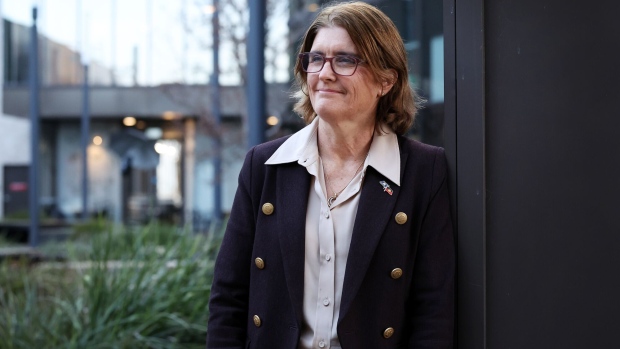Nov 5, 2023
RBA’s Bullock Set for First Rate Hike as Inflation Lingers
, Bloomberg News

(Bloomberg) -- Australia’s central bank is forecast to raise interest rates on Tuesday, ending a four-meeting pause as persistent inflation and broader economic resilience suggest a further clampdown is needed to cool prices.
The Reserve Bank will lift its cash rate to a 12-year high of 4.35%, an overwhelming majority of economists surveyed by Bloomberg predict, in what will be Governor Michele Bullock’s first hike since taking charge. The RBA is trying to ensure inflation falls back inside its 2-3% target by the end of 2025 and may signal further tightening is needed.
“The board could even discuss a possible 50-basis-point hike, but we doubt this would be delivered given the degree of hiking to-date and the realpolitik,” said Josh Williamson, chief economist for Australia at Citigroup Inc.
“Rates are not far enough above neutral to sufficiently restrain domestic demand growth at a time of high inflation,” he said. “This will not be fixed by just one more 25 basis-point increase.”
The board will also be presented with the RBA staff’s quarterly update of forecasts at the meeting. These will be released in the Statement on Monetary Policy on Friday. Economists expect only marginal changes to the outlook.
That’s one reason why a handful of respondents in the Bloomberg survey expect the RBA will leave the cash rate at 4.1% for a fifth straight meeting.
Policymakers may also put a greater emphasis on their desire to engineer a soft landing, pointing to a potential turning point in the labor market that will see it soften as well as relentlessly downbeat consumer sentiment.
“The RBA faces a difficult call,” said James McIntyre at Bloomberg Economics. “Inflation expectations are far more consequential and if the RBA judges those remain intact despite the fuel-price boosted inflation read, then expect rates to remain on hold. That’s how we think it will play out.”
Australia’s central bank has been more cautious than the Federal Reserve, raising rates by 4 percentage points during the current campaign compared with 5.25 points in the US. Bullock and her colleagues are mindful of the impact of tightening on Australia’s highly geared borrowers who are overwhelmingly on variable rates, unlike the US where most mortgages are fixed for 30 years.
Bullock has repeatedly stressed that a key economic uncertainty is how rising borrowing costs impact Australian households. She has described the current cash rate of 4.1% as “restrictive,” signaling a higher hurdle to hikes.
While worries about the health of the consumer remain, data is still pointing to broader economic resilience to elevated rates and prices.
Recent data showed surprisingly hot inflation, much stronger than forecast retail sales while house prices climbed for an eighth straight month. That combination has prompted traders to price in about a 70% chance the RBA will act on its hawkish bias at Tuesday’s meeting.
Bullock has highlighted difficulties in cooling inflation, pointing to still-sticky services prices and geopolitical shocks from Eastern Europe to the Middle East and rising tensions elsewhere.
A key cushion for the A$2.3 trillion ($1.5 trillion) economy is surging population growth that’s boosting demand for everything from housing to transport and dining out. Historically, migration has allowed Australia to dodge recession.
Economists in a Bloomberg survey see a 50% probability of a recession — defined as two consecutive quarters of falling GDP — over the next 12 months.
“A 25 basis-point hike in November means the consumer will struggle by more than anticipated by the RBA and a soft landing may become less likely,” said Micaela Fuchila, an economist at Bank of America Corp. “We think current economic conditions are weak and scope for further tightening beyond November is very limited.”
It’s also yet to be seen whether Australia’s labor market can keep absorbing the surge in overseas migrants. The jobless rate has hovered in a 3.4-3.7% range since June 2022, levels last seen in the early 1970s.
Adding to the RBA’s worries, figures Monday showed a gauge of Australian job ads fell 11.4% in October from a year ago. That suggests that “slack is slowly creeping into the labor market,” and that the unemployment rate will likely rise from here, said Madeline Dunk, an economist at ANZ Banking Group Ltd.
--With assistance from Tomoko Sato and Garfield Reynolds.
(Adds ANZ job advertisement in final paragraph, updates first chart.)
©2023 Bloomberg L.P.






